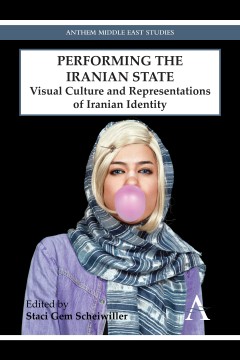Performing the Iranian State
Visual Culture and Representations of Iranian Identity
Edited by Staci Gem Scheiwiller
- About This Book
- Reviews
- Author Information
- Series
- Table of Contents
- Links
- Podcasts
About This Book
This book discusses what it means to “perform the State,” what this action means in relation to the country of Iran and how these various performances are represented. The concept of the “State” as a modern phenomenon has had a powerful impact on the formation of the individual and collective, as well as on determining how political entities are perceived in their interactions with one another in the current global arena.
“Performing the State” refers to an individual (or a group of persons) who re-enacts rituals, ceremonies, customs, traditions and laws, or who dons certain guises, that either accomplish the State’s goals or rebel against them as a form of critique. This anthology examines various approaches to determining the Iranian State via the performativity of persons, with the intention of illuminating how social practices, ideologies and identities are shaped, represented, visualized, circulated and repeated – not only nationally but also worldwide.
Reviews
“‘Performing the Iranian State’ is a timely and original contribution to Iranian studies. Beginning with the Qajar era and moving through discussions of the Pahlavi regime, the Iranian Revolution and the Iranian Diaspora, these essays present fascinating case studies of the productive function of visual culture and performativity in constructions of identity and state in Iran.” —Ali Behdad, John Charles Hillis Professor of Literature, UCLA
“Blending critical theory with fresh and exciting accounts of essential Iranian art agents, contributors to ‘Performing the Iranian State’ reveal how the country’s oft en-politicized artistic practices challenge or endorse and ultimately “perform” political and national identities. This compelling collection of essays is a seminal addition to the study of modern and contemporary Iranian art.” —Pamela Karimi, author of “Domesticity and Consumer Culture in Iran: Interior Revolutions of the Modern Era”
Author Information
Staci Gem Scheiwiller is an assistant professor of contemporary and modern art history at California State University, Stanislaus. She specializes in Iranian art, gender and postcolonialism.
Series
Anthem Middle East Studies
Table of Contents
Acknowledgments; A Note on Transliteration; 1. Introduction: Setting the Stage – Staci Gem Scheiwiller; I – THE QAJAR DYNASTY: 1786–1925: 2. The Photographic Source for a Qajar Painting – Donna Stein; 3. Cartographic Desires: Some Reflections on the “Shahr-e Farang” (Peepshow) and Modern Iran – Staci Gem Scheiwiller; 4. Takkiyeh Dowlat: The Qajar Theater State – Babak Rahimi; II – THE PAHLAVI DYNASTY (1925–1979) AND TRANSITIONAL PERIOD AFTER THE IRANIAN REVOLUTION (1978–1979): 5. For the Love of her People: An Interview with Farah Diba about the Pahlavi Programs for the Arts in Iran – Donna Stein; 6. Shaping and Portraying Identity at the Tehran Museum of Contemporary Art (1977–2005) – Alisa Eimen; 7. Seismic Shifts across Political Zones in Contemporary Iranian Art: The Poetics of Knowledge, “Knowing” and Identity – Abbas Daneshvari; III – THE ISLAMIC REPUBLIC: 1979–PRESENT: 8. Performativity and Ritual Space in Postrevolutionary Tehran – David Simonowitz; 9. Reclaiming Cultural Space: The Artist’s Performativity versus the State’s Expectations in Contemporary Iran – Hamid Keshmirshekan; 10. Female Trouble: Melancholia and Allegory in Contemporary Iranian Art – Andrea D. Fitzpatrick; IV – THE IRANIAN DIASPORA: 11. Performing Visual Strategies: Representational Concepts of Female Iranian Identity in Contemporary Photography and Video Art – Julia Allerstorfer; 12. Painted and Animated Metaphors: An Interview with Artist Alireza Darvish – Mina Zand Siegel and Carmen Pérez González; 13. In the House of Fatemeh: Revisiting Shirin Neshat’s Photographic Series “Women of Allah” – Staci Gem Scheiwiller; Illustrations; List of Contributors
Links
Stay Updated
Information
Latest Tweets



